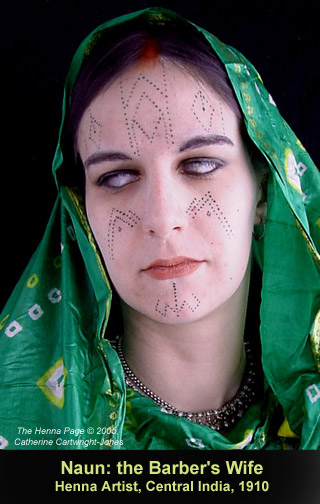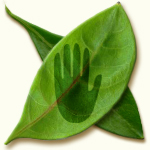a henna artist from Central India, 1910
Catherine Cartwright-Jones2005
TapDancing Lizard Publications
Click here to download a printable PDF of this article

Recreation of:
Nai: Henna Artist: Central India, 1910
The British Library photograph 41/2 (22) Negative # 10554
R.L Desai, Gwalior
|
In
traditional India, under the caste system, people were born into their
occupations. People learned the family trade and worked those
jobs through their lifes. The traditional henna artists in India
were Nai caste. Nai men were barbers, circumcisers, and they did
minor surgeries. Nai women, Naun, were hairdressers, henna
artists, and midwives. Nai were part of the Shudra caste.
Shudra were artisans and craftsmen: woodworkers, gardeners, herders,
laundresses, potters, and barbers. The Shudra caste was just
above the Harijan caste, the “Untouchables,” but was lower than all
other castes.
All people in the Shudra castes were regarded as inferior to upper castes, because of their impurity. Impurity came from contact with “polluting” substances and social situations. The lowest caste, the Harijan, came in contact with the dead, pigs, and excrement. Among the Shudra, the Mirasis, singers, were superior to henna artists. Singers could entertain upper castes, and were exposed to their gaze, but they didn’t have to touch them. Nai touched hair, feet and blood, and thus were more polluted than singers. The Dhobi, laundresses, were inferior to henna artists because laundering is a more polluting activity as it involves handling clothing soiled with dirt, excreta, and menstrual blood. If a Brahmin was shaved or hennaed by a Nai, the Brahmin was “polluted” by that contact. The Brahmin would have to wash away the pollution before performing a religious function. One Nai family would serve a town, or a few small villages. The Nai man had regular clients. He would go from house to house to shave the men and groom their hair and beards. His wife would also go from client’s house to the next to dress women’s hair, and apply henna, lac, and kumkum. Naun were allowed to pass freely through the streets from one home to another. Because of this mobility, the Naun were used as matchmakers, carrying the descriptions of available sons and daughters to mothers wishing to find suitable mates for her children. Naun were also used as “go-betweens” for adulterous liaisons, carrying messages between lovers. Since the Nai knew the secret affairs of their clients, even to the extent of hiding illegitimate births through midwifery, no one ever completely trusted them. In the Indian census of 1891, Volume II Castes of Marwar, in a total population of 2,518,007, there were 1,467 Nai, in contrast to 206,842 people of priestly caste. R.L Desai, a photographer in Gwalior, photographed a Nai woman from central India in 1910. This photograph is in the British Library, 41/2 (22,) negative # 10554. Though her occupation would have been hairdressing, henna application and midwifery, she was blind. The blindness appears to have been caused by trachoma, an endemic disease carried by flies. In the 1981 Marwar census, 7,505 of 1,194,231 women were blind, mostly from trachoma. Trachoma is an easily preventable disease, and occurs where people are very poor, have little access to medical care, do not have clean water for washing their faces and eyes, and have open latrines. Flies carry the vector microorganism, Chlamidia trachomatis, from one unwashed face to another, especially when children are sleeping unattended. In the Marwar census, blindness affected 40% more women than men, probably because male children were allowed more of their mother’s attention and resources than females. The above photograph is a recreation of the original photograph in the British Library. The model in this photograph is Jen, a henna artist in Ohio, who does NOT have trachoma, nor is her face actually tattooed. The tattoos were done with harquus, as detailed at http://www.harquus.com, and her eyes were photographically altered. Online references for Nai Caste: http://www.csuchico.edu/~cheinz/syllabi/asst001/spring98/india.htm http://www.hvk.org/articles/0303/145.html http://anthropology.ac.uk/Mulpur/Source/SurveyData/occPie.html http://www.cpiml.org/liberation/year_2004/December/party_building.htm http://faroutliers.blogspot.com/2004/07/naipaul-on-barber-factotum-of.html http://www.boloji.com/wfs/wfs073.htm References: Desai, R.L. Nai: Henna Artist: Central India, Gwalior, 1910 The British Library photograph 41/2 (22) Negative # 10554 Report on the Census of 1891, Volume II Castes of Marwar Published by the order of Marwar Darbar, Johpur, 1894 Zingeser, J. A. Sight for Sore Eyes. Natural History, Dec2004/Jan2005, Vol. 113 Issue 10, p34, 6p, 6c Return to the Encyclopedia of Henna Index Can't find what you're looking for? Try: The Henna Page Main Index http://www.hennapage.com/henna/mainindex.html the Encyclopedia of Henna Catherine Cartwright-Jones c 2000 registered with the US Library of Congress TXu 952-968 Logo by Alex
Morgan:
Spellstone © 2005
All material unless otherwise noted by Catherine Cartwright-Jones © 2003, 2004, 2005 info@mehandi.com Title Graphics by Gwyneddh Jones © 2003
|

